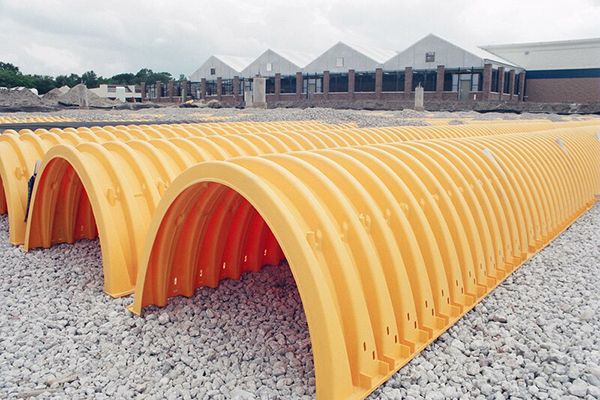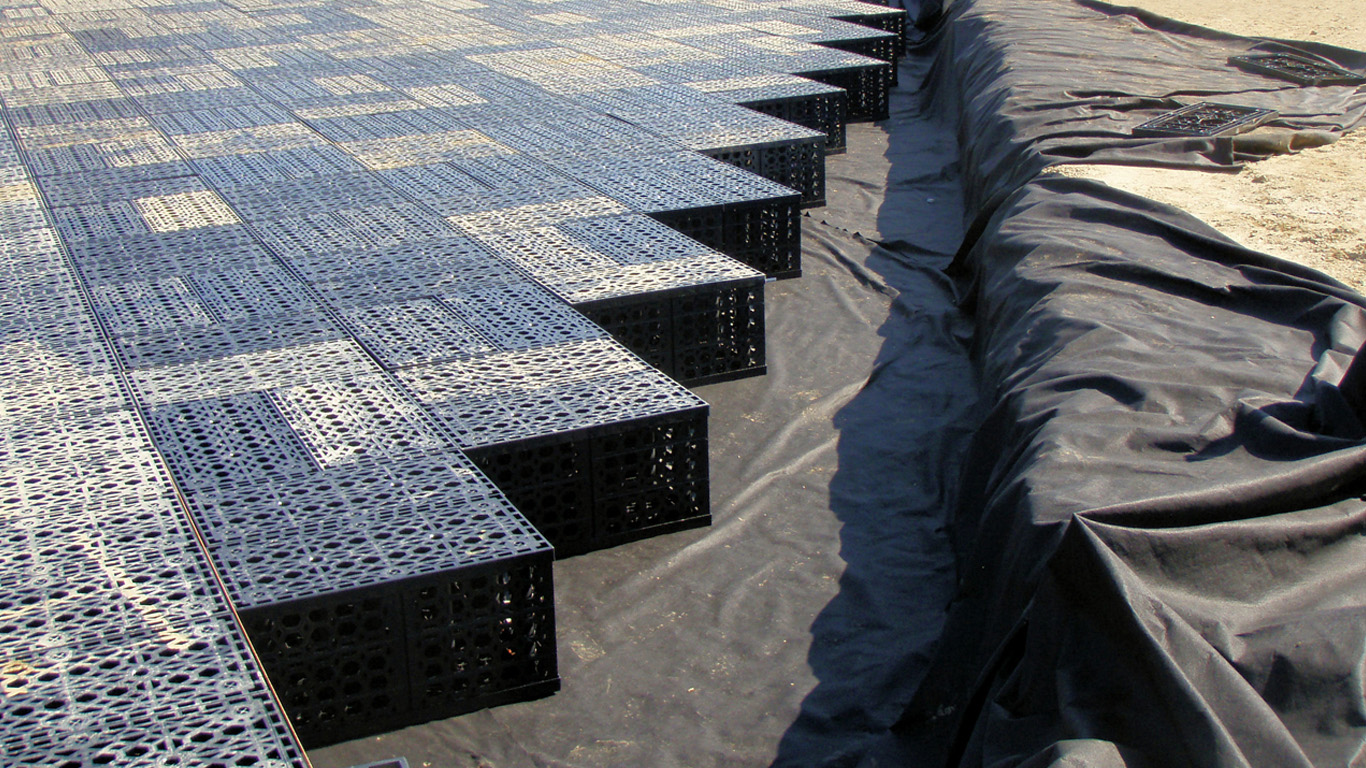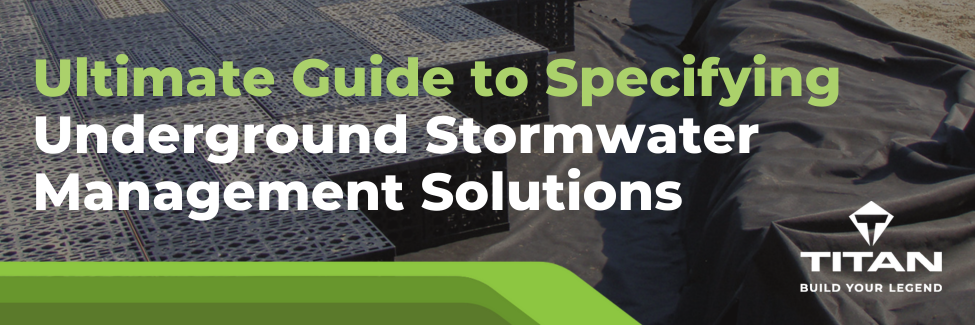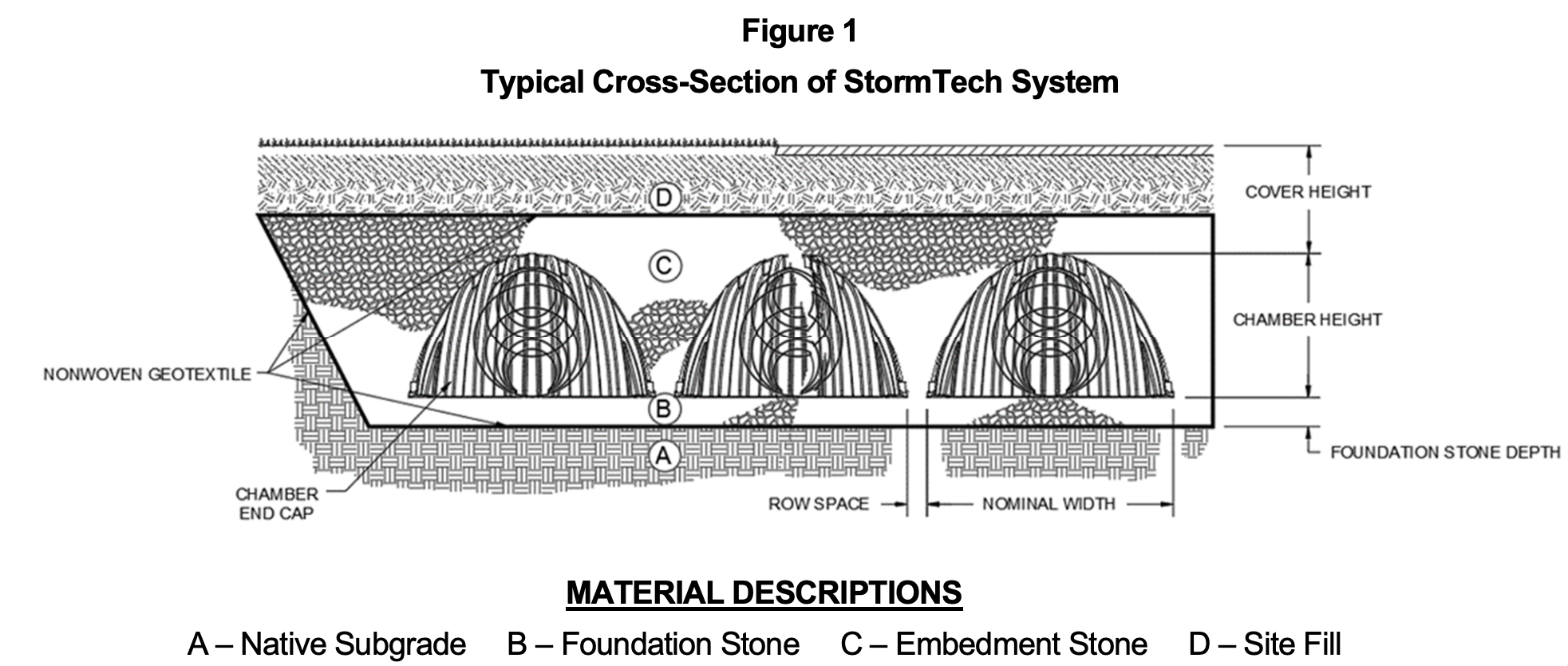Stormwater Management addresses the impact of stormwater runoff on urban and rural development. It is an important consideration for projects where there are needs related to water detention and infiltration, flood mitigation, and surface water runoff.
Why choose an underground stormwater system for stormwater management applications?
- Highly effective at managing stormwater runoff
- Designed to capture and store stormwater underground, allowing it to slowly filter into the ground over time
- Reduces the amount of stormwater runoff that enters streams, rivers, and other bodies of water, which can help to reduce flooding and erosion
- Can be designed to filter out pollutants and other contaminants, which can help to improve water quality.
Stormwater management is site-specific, and no single solution can be recommended. Detail and precision are imperative to the planning, designing, and construction phases.
If you’re an engineer that’s currently planning an underground stormwater or flood mitigation project, this guide will help you learn more about successful underground stormwater management and how to correctly specify StormTech® Arch Chambers and/or StormTank® Modules.
What you’ll get:
StormTech® Arch Chambers:
StormTank® Modules:
Plus:
StormTech® Chambers
Designed to be used under parking lots, roads, playgrounds and other facilities, the StormTech® chamber system helps save valuable land space by increasing useable land while also protecting water resources by adhering to sustainability standards. Its structural durability can handle heavy loads and offers an impressive 75-year design life.

Features and Benefits
The StormTech® underground stormwater arch chamber system is known as one of the most revolutionary engineered stormwater management solutions on the market.
- Designed to be used under parking lots, roads, playgrounds and other facilities.
- Saves valuable land space by increasing useable land while also protecting water resources by adhering to sustainability standards.
- Structural durability can handle heavy loads and offers a 75-year design life.
- Available in various sizes and suitable for major commercial construction site drainage requirements and residential neighborhoods.
Product Benefits:
- Volumetric reduction of stormwater through infiltration.
- Stormwater quality through patented isolator® Row (TSS, TP and TPH removal).
- Reduction of thermal impacts.
- Design flexibility; can be configured into beds or trenches of various shapes/sizes.
- Proven, third party verified performance.
- Easily Constructed, Inspected and Maintained.
- Meets ASTM product standard.
- Designed to ASTM & AASHTO specifications.
Suitable Applications
- Stormwater runoff reduction
- Water sustainability
- Rainwater detention
- Underground stormwater retention
- Underground stormwater infiltration
- Rainwater harvesting
- Enhancing green infrastructure
Required Materials
For every StormTech® application, fill material and geotextiles are required.
Required fill materials include:
- Foundation stone: Clear, crushed granular stone.
- Embedment stone: Clear, crushed granular stone.
- Initial fill: Granular, well-graded soil/aggregate mixtures, <35% fines or processed granular. Most pavement subbase materials can be used as a substitute.
- Final fill: Any soil/rock materials, native soils, or per engineer’s design plans.
Acceptable geotextiles:
- Woven geotextile
- Non-woven geotextile
Installation Tips
Proper embedment and backfill material are vital for a stable soil-structure system. They reduce load on thermoplastic components, limit deflection and strain, and prevent failure. Designs that require no structural embedment and backfill material and are not designed in accordance with AASHTO requirements may result in excessive deflections or complete failure.
StormTech® advises that a porosity of 40% is appropriate to use for the storage capacity of structural aggregate used in the bedding and embedment zones around StormTech® chambers.
Non-woven geotextile is used as a boundary between the soil/stone interface to line the entire system. It should line the excavated pit and sidewalls during installation. The fabric should overlap by at least 2 inches wherever sections of the fabric meet.
Woven geotextile is used between the chambers and the base stone only. A strip of woven geotextile should run the entire length of the Isolator Row, between chambers and base stone. An Isolator Row is a row of StormTech® chambers that is completely encased in geotextile filter fabric and acts as a sediment trap.
Subgrade Performance Considerations
Bearing Capacity: Bearing capacity failure is not tolerable. Local shear (punch shear) must be a design consideration.
Settlement: The chamber system is tolerant to minor settlement. For design, total settlement at any point should be limited to 3 inches (76 mm). Differential settlement should not exceed 1 inch (25 mm) across one chamber structural span. Settlement tolerances are intended to provide the basis for foundation design and ensure the structural performance of the chamber-soil system.
Subgrade Saturation: If no impermeable liner is specified and the system design allows for infiltration, water content of the subgrade soil is expected to increase above natural levels immediately after a storm event. If an impermeable liner is used, the system will not increase the saturation of the subgrade.
StormTank® Modules
The StormTank® Module is an above-par subsurface modular stormwater management system used to regulate stormwater flow and provide large-volume storage. Created respectively for project professionals to achieve a quick turnaround and load-rated for extreme applications like heavy trucks or under-fire access roads. It contains a higher void space than other water storage solutions.

Features and Benefits
StormTank® Module 20 Series:
- Efficient for use under standard applications such as parking lots and athletic fields.
- Commonly used for stormwater retention, detention, infiltration, and rainwater harvesting.
- Simplified design allows for quick assembly and requires fewer total units.
- Functional design translates into a reduction in installation time and labor costs for a customer.
StormTank® Module 25 Series:
- Offers maximum strength and utilizes area effectively.
- Commonly used for stormwater retention, detention, infiltration, and rainwater harvesting.
- Flexible design helps meet and achieve strict runoff regulations.
- Functional design (stackable and a range of column heights) helps reduce the installation footprint.
Product Benefits:
- Module 20 Series: Fully factored HS-20 load rating.
- Module 25 Series: Fully factored HS-25 load rating.
- Extensively tested in a full-scale installation setting.
- Maximum 97% void space.
- Available in six heights, including 12-, 18-, 24-, 30-, 33- and 36-inch.
- Module 20 Series nominal footprint: 21” x 42”
- Module 25 Series nominal footprint: 18″ x 36″
- Box structured and stackable.
- Easy to install (Assembled in two minutes or less)
Suitable Applications
- Stormwater runoff reduction
- Water sustainability
- Rainwater detention
- Underground stormwater retention
- Underground stormwater infiltration
- Rainwater harvesting
- Enhancing green infrastructure
- Flood Mitigation
Required Materials
For every StormTank® application, fill material and geotextiles are required.
Required fill materials include:
- Leveling bed: Crushed angular stone placed to provide level surface for installation of Modules
- Side backfill: Crushed angular stone placed between earthen wall and Modules
- Top backfill: Crushed angular stone placed between Modules and road base or earthen fill
- Suitable compactable fill: Well-graded granular soil/aggregate, typically road base or earthen fil (maximum 4″ particle size)
- Finished surface: Topsoil, hardscape, stone, concrete, or asphalt per Engineer of Record
All stone must be angular stone meeting ASTM D2321. Recycled concrete may be utilized when meeting acceptable gradation and ASTM standards.
To prevent material migration around the excavation, a layer of geotextile fabric is required. In addition, an impermeable liner may be incorporated to prevent infiltration.
Specification and Installation Tips
To design a successful underground stormwater management system, a soil evaluation is always required as the first step to determine the properties of the soil, potential limiting zone depths, and the suitable infiltration rate.
To ensure runoff can infiltrate efficiently, infiltration basins rely on the hydrologic capacity of the soil and overall footprint of the structure. Detention and retention systems are more focused on capacity and rate control.
Testing the Infiltration Rate
The most common method for testing infiltration rate is a double-ring infiltrometer test where a double cylinder is embedded into the native soil and both the inner and outer cylinders are filled with water. As the water is allowed to percolate into the native soil, the results of the drop in the inner cylinder are measured. This data is recorded in conjunction with the length of the test, providing a rate in inches per hour.
Adequate Subgrade Design
The infiltration capacity and the structural stability of the system is dependent on the subgrade design. The soil that supports the system must meet the following requirements:
- Adequate bearing capacity to support weight of the system, backfill materials & live loads applied at the surface
- Adequate resistance to differential settling
If the soil is incapable of meeting these requirements, further mitigation measures such as soil compaction are required.
Meeting Treatment Capacity Requirements
The required treatment capacity of the infiltration basin will be dependent upon local regulations. The volume that needs to be infiltrated, the infiltration rate, and the allowable infiltration time (24‐48 hours) will determine the square footage of the installation.
Application Footprint
For applications with restricted sites, system footprint is critical. In infiltration applications, the site footprint is significant for the function of the system. Reducing the footprint could cause the system to no longer meet the design specifications or regulations.
In detention and retention applications, the site footprint can impact the storage and discharge rate used to size the system. In detention applications, the design should fit as much storage in as small a footprint as possible, even if more space is available.
Determining Separation Fabric
Both the stone/soil interface and the stone/module interface require separation via non-woven geotextile fabric. Separation at the stone/soil interface prevents the soils and stone from migrating as the soils become saturated. Separation at the stone/module interface prevents the backfill material from entering the module through void space.
StormTank® Module installation requires 7 steps:
- Module Assembly
- Basin Excavation
- Subgrade Preparation
- Leveling Bed Installation
- Module Placement
- Side Backfill
- Top Backfill
Integration with Green Infrastructure
Green infrastructure is a component of Low Impact Development (LID). LID is an innovative approach to urban and suburban development that aims to mitigate the negative environmental impacts of traditional land development. This type of development is designed to work in harmony with the natural environment, rather than against it, by reducing stormwater runoff, preserving natural habitats, and minimizing the use of non-renewable resources.
Examples of green infrastructure that StormTech® chambers and StormTank® modules can be combined with are
- Pervious pavement: Paving methods for roads, parking lots, and walkways that allow the movement of water and air through the paving material.
- Rain gardens and bioretention systems: A shallow depression planted with suitable vegetation that is used to store and possibly treat stormwater runoff from impervious areas.
- Downspout connections: A pipe that directs stormwater runoff from the roof of a house to the ground.
- Rainwater harvesting: The collection and storage of rain, rather than allowing it to run off. Rainwater is collected from a roof-like surface and redirected to storage system.
Maintenance and Lifecycle Assessment
Underground stormwater systems can last anywhere from 20 to 100 years. The thermoplastic materials used for these systems are very stable in stormwater conditions. The primary benefit of underground systems is to facilitate additional paved surfaces for the purpose of parking or traffic flow. For such applications to be safe, it must account for uncertainties in loading, installation, and material performance.
Buried thermoplastic products must be designed for 3 conditions:
- Short duration live loads under shallow cover
- Minimum 1-week sustained loads
- Permanent earth loads
Preventing sediment buildup is another maintenance consideration that should be made. Sediment buildup can cause reduced storage capacity and infiltration rate. Providing areas for sediment capture and removal as part of the system design can make maintenance easier and eliminate the need to flush the entire system.
Let’s Work Together
Ready to specify a StormTech® Chamber or StormTank® Module for an underground stormwater management system?
We offer various underground stormwater management solutions with design consultation, so your site and investment are protected.
Connect with our stormwater management team using the form below!


